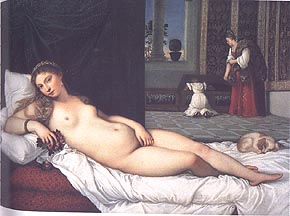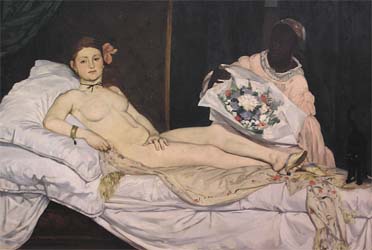Art Home | ARTH Courses | ARTH 200 Assignments
Gender in Perspective
Excerpts from Rebecca Schneider, "Permission to See- Gender in Perspective: Have We Really Gone Beyond?," The Explicit Body in Performance (New York & London: Routledge, 1997).
In league with the humanist ideals of the Renaissance, perspective secularized the godhead into the eye of the beholder, and gendered that beholder after the gender of God. As John Berger remarks of this transformation, "The visible world is [in perspectivalism] arranged for the spectator as the universe was once thought to be arranged for God." Like God, the viewer is unseen. Conventions of perspective instituted and humanized the distantiation of omniscience, veiling and dislocating the viewer from the viewed by the secular science of mathematical proportion. As Martin Jay has noted,"The painter's own body...was effectively banished", even as the painter (and by extension the viewer) was presumed to be gendered, like God, male. The marker of the viewer /artist's godly gender was veiled, displaced on to his prerogatives of vision. In contrast, the given to be seen was rendered embodied object, reproducible by mathematic proportion and calculable distance: located, fixed and blinded. The scopic field was feminized as passive --as accessible as it was, by virtue of the vanishing point, inaccessible. Men and women who appeared in the scopic field were fixed --sometimes in poses of pride and arrogance, as their portraits rooted their propriety into recessive eternity, beckoning an envy on the part of the viewer. Women were often undressed and spread across the terrain as emblems of the scopic field itself, beckoning the viewer to gaze and the insatiability of his desire. She stretched across the field as an emblem of his desire to acquire that which, again by logic of the vanishing point could never be fully acquired.
Classic perspective
orients the field of vision to the viewer's veiled or vanished body, as if
the scene itself emanates from the viewer's own gaze. The scene is subservient
to that eye, at the same time that that eye is erased from implication in
the visual field. Within the terms of perspective, there is no reciprocity
--the seen does not see back. Classically, even if the seen is presented so
as to be looking at the viewer (as in Titian's The Venus of Urbino or Edouard Manet's Olympia
or Edouard Manet's Olympia )
what is acknowledged by the direction of her gaze (whether defiant or
compliant) is the viewer's sight marking her as seen. She can only acknowledge
that she is seen, but she cannot author vision, cannot see back. She does
not render the viewer visible. Rather, she renders him sighted. Emblematic
of the scopic field itself, she is the vision and he has the
vision --she is the vision he has-- just as Lacan would engender the logic
of the fetish at the base of the Symbolic Order: she is the (fetishized) phallus,
he has the phallus, she is the phallus he has.
)
what is acknowledged by the direction of her gaze (whether defiant or
compliant) is the viewer's sight marking her as seen. She can only acknowledge
that she is seen, but she cannot author vision, cannot see back. She does
not render the viewer visible. Rather, she renders him sighted. Emblematic
of the scopic field itself, she is the vision and he has the
vision --she is the vision he has-- just as Lacan would engender the logic
of the fetish at the base of the Symbolic Order: she is the (fetishized) phallus,
he has the phallus, she is the phallus he has.
Interestingly, the institution of perspective actually theatricalized the field of vision, creating "scenographic space" in which all that is given to be seen is, in a sense, staged for the viewer --liad out before him like his own future. In this sense, importantly, the seen became spectacle, an always already theatrical masquerade, a parade of desire, a dreamscape of wishes spread for potential consumption. This scenographic orientation in perspectivalism is, as Jay notes, "a notion of space congenial not only to modern science, but also, it has been widely argued, to the emerging economic system we call "capitalism." The given to be seen grants an access to an "actual" marked by distance from the viewer. That distance beckons and simultaneously denies, invoking possession at the same time that it expands into an infinite, inaccessible dreamscape of masquerade hinged on the vanishing point. It is an inscription of distance and penetrability --a distance across which desire can be constructed as insatiable, and so constructed, can work its magic as the unending drive to accumulate, appropriate, possess and acquire.
Despite any number of attempts to find ourselves beyond the grip of perspectivalism or to locate nonperspectival roots in Western concepts of representiation --scuh as Martin Jay's (1993) thesis that the denigration of vision in the twentieth century has led to the end of ocularcentrism, or Svetlana Alper's attention to generally ignored nonperspectival traditions in painting-- the historical primacy of perspectivalism, at the very least in our historicizing of art, is indisputable. Works which wrestle with the legacies of perspective reckon with the ghosts of those habituations. Sitting, watching, we conjure these ghosts, whenever we look for narrative line. "Woman", whenever we recognize here signs, rebounds with the cultural construction of desire as insatiable, a narrative linked to the feminization of the scopic field as open for possession --a narrative replete with the heterosexual imperative which renders the "phallic ghost" as modus operandi of seeing [...]
In late capitalist renditions of perspective, then, insatiability still reigns: the image /comodity does not "give" what it promises, the viewer does not "get" what he desires --he is destined to spend himself unseen, un(re)marked by the blinded object of his gaze, to try and try again, ritually stabbing at his own eyes like Oedipus. Ultimately he imagines he can give up on vision altogether in orgasmic thrall with his narrative of loss. The image, the object, is what must be "gotten" or abandoned. The given to be seen, like the commodity itself, is never considered to "get", but only to "give" or to deny.
To return
to the roots of perspective, it is not inconsequential that the institution
of the vanishing point and its logic of insatiability marked the institution,
the 'discovery' of a previously inconceivable notion of infinity. As Erwin
Panofsky has explained, the vanishing point in perspective is relative to
a shift in worldview from the concept of a closed universe to an infinite
expanse, a never-ending recession and expansion of space, endlessly purveyable
by an enterprising, colonizing and capitalizing subject /gaze. The vanishing
point, as mirror site of the viewer's dislocation, services enterprise and
is elusively contained within the terrain of the envisioned, the commodified,
as thus the feminine. The feminine, as emblematic of the given to be seen,
became terrain, virgin territory made passive before a veiled masculine gaze.
[Compare this point to this sixteenth engraving entitled America showing
Amerigo Vespucci "discovering" America. Read the recent
critical responses to this image.] "She" is thus figured both
as that which is traversable, the object possessable, and the inaccessible,
the vanishing point, the vanishing point of present knowledge --that which
infinitely recesses, endlessly escaping the boundaries of phallocratic ordering.
As that which is rendered visible as well as that which slips beyond vision,
woman became emblematic of the modernist paradox of possessable infinite --she
is given to be origin as well as death in a universe which, paradoxically,
contains no beginning and admits no end. Thus in the broad symbolic picture
woman became, as Freud would acknowledge, a riddle-- a riddle marked, above
all, by sexuality.
showing
Amerigo Vespucci "discovering" America. Read the recent
critical responses to this image.] "She" is thus figured both
as that which is traversable, the object possessable, and the inaccessible,
the vanishing point, the vanishing point of present knowledge --that which
infinitely recesses, endlessly escaping the boundaries of phallocratic ordering.
As that which is rendered visible as well as that which slips beyond vision,
woman became emblematic of the modernist paradox of possessable infinite --she
is given to be origin as well as death in a universe which, paradoxically,
contains no beginning and admits no end. Thus in the broad symbolic picture
woman became, as Freud would acknowledge, a riddle-- a riddle marked, above
all, by sexuality.
As woman, like the horizon, contains the vanishing point of her difference-- her sex is marked as lack-- then the aim to possess her could never be fully satiated, propelling infinite exchange, and the consumer's quest for the feminized object of masculinized desire became, as Luce Irigary put it, a "game of Chinese boxes. Infinitely receding." We read the female body as sex, but dominant tropes of heterosexuality play on both the overly visible terrain of bodily matter and on the slippery slope of language, "engenderment", the arena of language and its limits. Lacan placed language in symbolic league with the scopic field, catching language and vision in a thoroughly tangled embrace. To quote Jacqueline Rose, explicating Lacan, sexuality is conceived as the "vanishing point on meaning". And thus, as femist criticism has so often pointed out, "woman" --the traversable field, the site of sex-- is constantly caught as that which cannot be caught, known as that which cannot know or be known, meant as that which cannot mean. Emblem of consumptive desire and designated capitalist consumer, she sets out to consume herself in an anotectic frenzy of the logic of the vanishing point-- attempting to consume her own inaccessible image, chasing after disappearance infinitely.